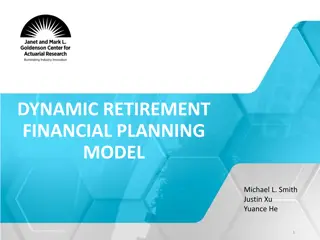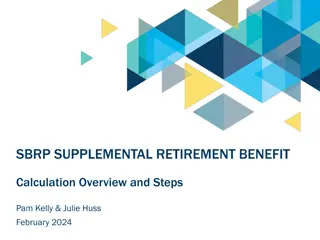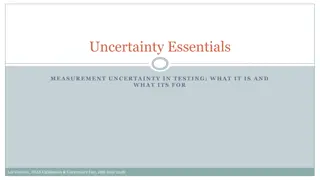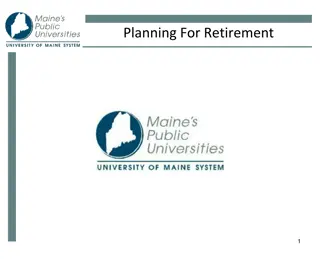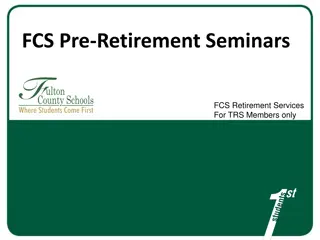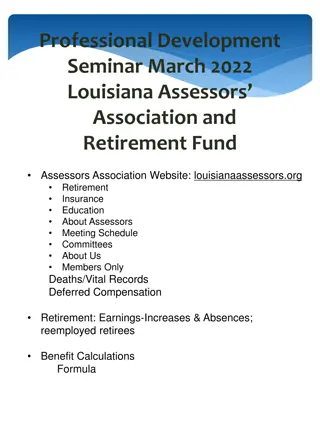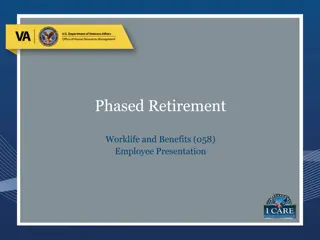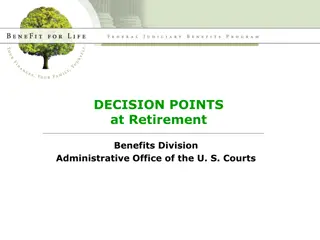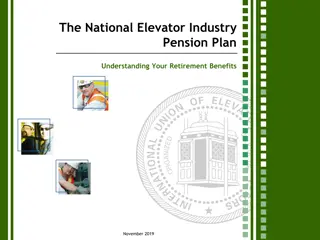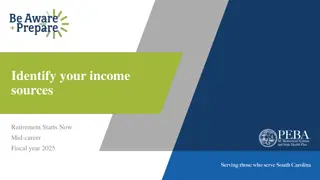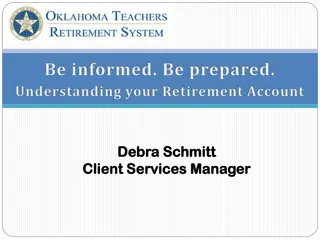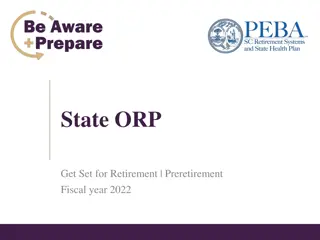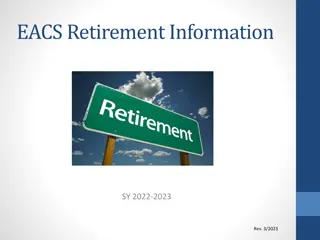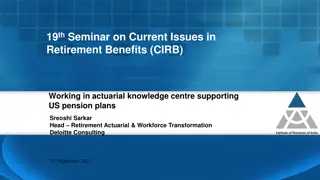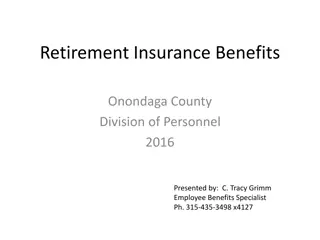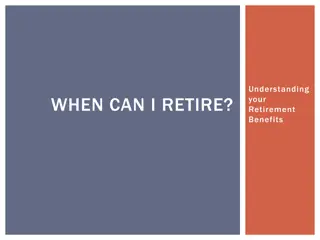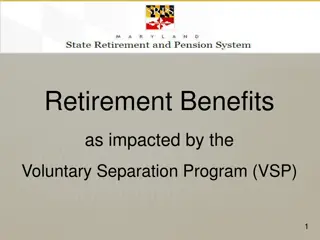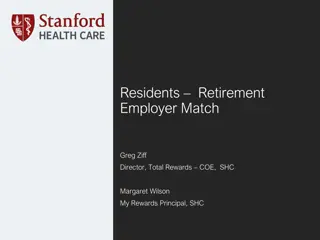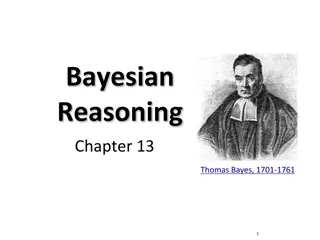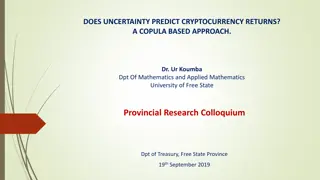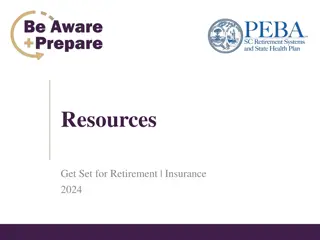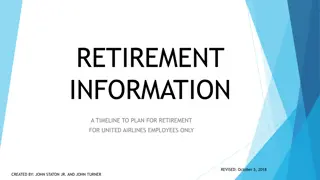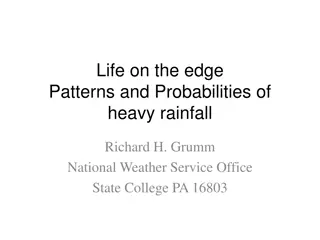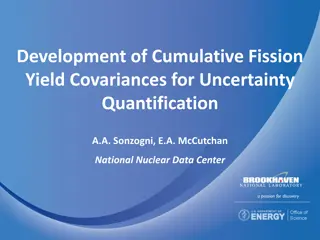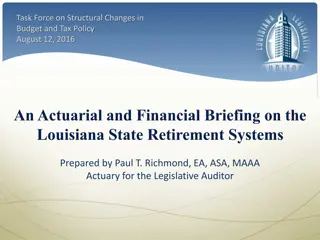Retirement Planning Strategies and Uncertainty Analysis
Explore the key concepts of retirement planning, including the accumulation and spending phases, determining target wealth, asset allocation decisions, generating a wealth path, and managing uncertainty in portfolio returns. Learn how to calculate savings, set financial goals, and navigate market fluctuations to secure a stable retirement income.
Download Presentation

Please find below an Image/Link to download the presentation.
The content on the website is provided AS IS for your information and personal use only. It may not be sold, licensed, or shared on other websites without obtaining consent from the author. Download presentation by click this link. If you encounter any issues during the download, it is possible that the publisher has removed the file from their server.
E N D
Presentation Transcript
Uncertainty and Retirement Planning Lecture for FIN 352 Professor Dow CSUN 2016
The situation (from the last presentation) Save and invest money until retirement (the accumulation phase) Once retired, withdraw money from investment accounts (the spending phase) We solved the problem in reverse order Spending phase: How much do you need each year in retirement? This determines desired (target) wealth at retirement Accumulation phase Goal is to end with the targeted level of wealth How much do you need to save to reach the target?
Timeline of Wealth Wealth Add money each year Withdraw money each year End of Life Now Date of Retirement
The accumulation phase Two decisions How much to save each month The asset allocation This affects the portfolio return (and risk) On a financial calculator N: number of years to retirement PV: starting wealth PMT: How much you save each year I: The return to your portfolio FV: Your target wealth
Generating an wealth path Wealth grows over time because: Additional savings Under your control given your income Reinvested income generated by your assets Cannot control returns in the markets, but Average returns and risk depends on asset allocation of your portfolio Equation: Wt+1 = (1+Rt)Wt + St W: Wealth S: Savings R: Portfolio Return
Wealth path if no uncertainty Wealth Target Wealth Retirement Date Start Date
Uncertainty of portfolio return Treat Ras a random variable If asset allocation is between stocks and bonds, Portfolio return in a given year is an average of the return on stocks and the return on bonds Rp = xRs + (1-x)Rb (where x is the share of stock in the stock in the portfolio) Assuming a normal distribution for stock and bond returns E(Rp) = xE(Rs) + (1-x)E(Rb) p= sqrt( x2 s2 +(1-x)2 b2 +2x(1-x) s b sb ) Portfolio returns ~N(E(Rp), p)
Generating a sample wealth path Each year draw random variable from N(E(Rp), p) Update wealth using Wt+1 = (1+Rt)Wt + St Continue until you hit the retirement date This is one possible path that your investment future could take. This is called a simulation
Generating a wealth path Wealth Target Wealth Retirement Date Start Date
Generating a distribution No guarantee of any particular outcome Many possible paths Monte Carlo analysis Randomly generate 1,000 s of possible paths Summarize results by distribution of ending wealth
Generating a distribution Probability distribution of wealth at retirement Wealth Target Wealth Total probability of not meeting goal Retirement Date Start Date
How do we measure success? Traditional risk measures Standard deviation (as measure of uncertainty) Sharpe ratio (as measure of reward-to-variability tradeoff) Downside Risk: Probability of not-meeting goals Probability distribution of wealth at retirement How often do we end up with less wealth than our target? And by how much? Other measures Maximum Drawdown Sortino Ratio (Rp-Rt)/DR DR= Downside semi-deviation
Monte Carlo simulator in Excel On class website Three asset classes Stocks Bonds Cash Assumptions Set distributions for three asset classes Length of time until retirement Target wealth Choices Asset allocation Starting Increase or decrease each year Evaluation Shows probability of missing the target If this is too high (or too low) Change asset allocation strategy Change target wealth Change years to retirment
The spending phase Goal is to make sure you do not outlive your money Two decisions How much to withdraw each year The asset allocation This affects the portfolio return (and risk) On a financial calculator N: number of years to retirement PV: wealth at retirement PMT: How much you withdraw each year I: The return to your portfolio FV: Ending wealth (0 in case with no uncertainty, or > 0 if bequests)
The spending phase Risk from? Uncertain lifespan Asset returns Expenses How long will you live? Life tables can show median life expectancy 50% chance you will live longer Should plan for living longer than life expectancy This gives you target date for how long your wealth should last
Sample wealth paths in retirement Wealth Successful path Unsuccessful path Retirement Date Target Date Ran out of money too soon
Monte Carlo simulators Fixed target date Chose asset allocation and withdrawal strategies Withdrawal strategies as Levels Rates Generate wealth paths Calculate probability of running out of money If risk is too high Reduce spending Change asset allocation Problem is that reducing risk also reduces expected return
Handling risk of life expectancy Be conservative, plan for a longer retirement phase Chose withdrawal rate accordingly Annuitize Social security and defined-benefit pensions Own your home Life annuities



